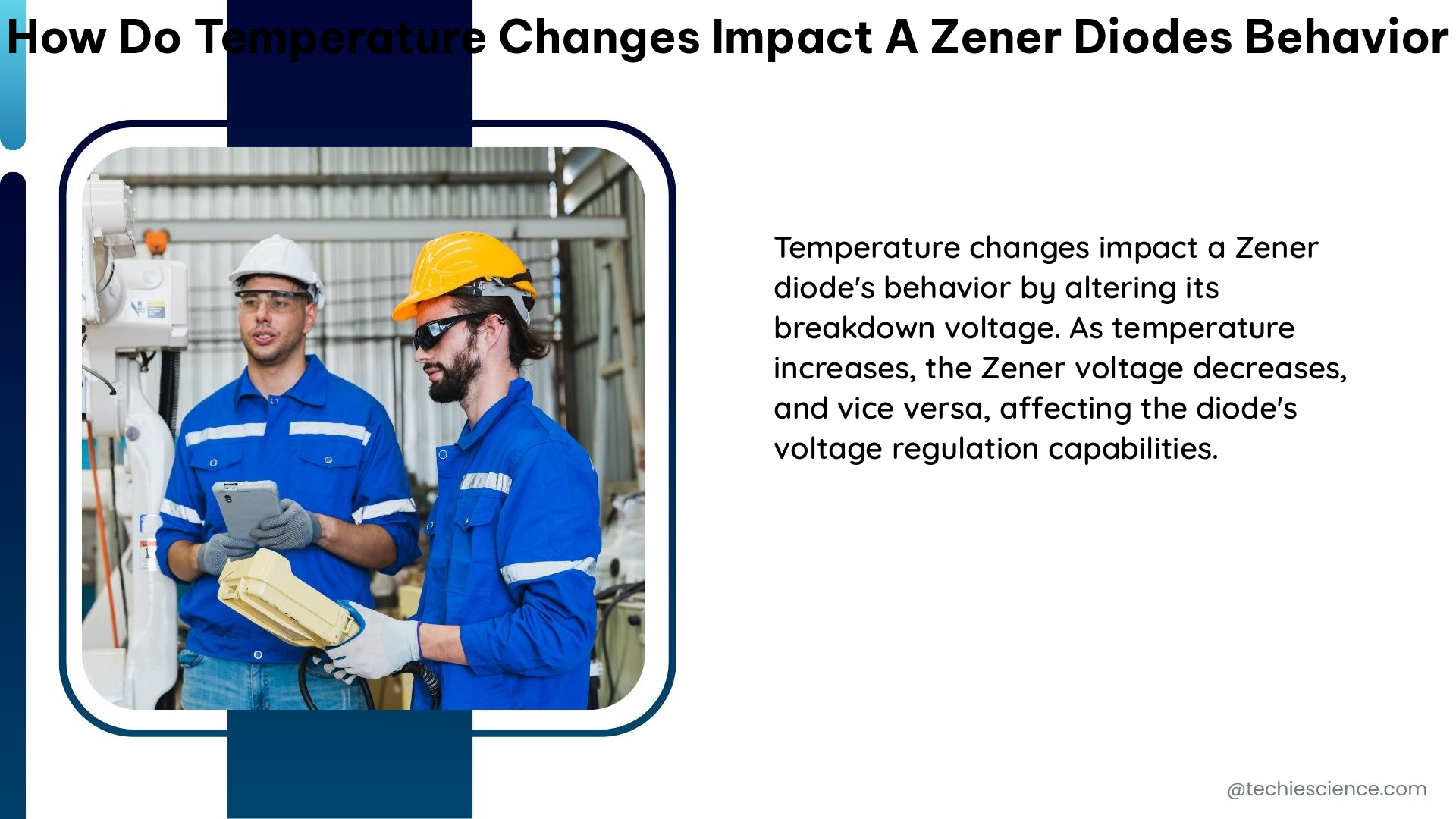Temperature changes have a significant impact on the behavior of Zener diodes due to their voltage temperature coefficient (αvz). This coefficient represents the percentage change in Zener voltage per degree Celsius (%/°C) or millivolts per degree Celsius (mV/°C). The αvz can range from -0.09 %/°C for low-voltage Zeners to as high as +0.110 %/°C for high-voltage Zeners.
Understanding Zener Diode Voltage Temperature Coefficient (αvz)
The voltage temperature coefficient (αvz) of a Zener diode is a crucial parameter that determines how the Zener voltage (VZ) changes with temperature. This coefficient can be either negative or positive, depending on the Zener voltage range.
Negative αvz for Low-Voltage Zeners
- For Zener diodes with voltages below 5V, the αvz is typically negative, ranging from -0.09 %/°C to -0.02 %/°C.
- In this voltage range, the Zener breakdown mechanism is dominated by field emission or “tunneling breakdown,” which exhibits a negative temperature coefficient.
- As the temperature increases, the Zener voltage decreases, and vice versa.
Positive αvz for High-Voltage Zeners
- For Zener diodes with voltages above 5V, the αvz is typically positive, ranging from +0.02 %/°C to +0.110 %/°C.
- In this voltage range, the Zener breakdown mechanism is dominated by avalanche breakdown, which exhibits a positive temperature coefficient.
- As the temperature increases, the Zener voltage increases, and vice versa.
Transition Region around 5V
- Zener diodes exhibit a negative to positive temperature coefficient “transition” in the vicinity of 5V.
- In this transition region, the Zener voltage is less affected by temperature changes, and the αvz is close to zero.
Calculating Zener Voltage Change (ΔVZ) with Temperature

The voltage change (ΔVZ) of a Zener diode can be calculated for a given change in junction temperature (ΔTJ) from an initial ambient temperature (TA) of 25°C using the following formula:
ΔVZ = αvz × VZ × ΔTJ / 100
Where:
– ΔVZ is the change in Zener voltage (in volts)
– αvz is the voltage temperature coefficient (in %/°C)
– VZ is the initial Zener voltage (in volts)
– ΔTJ is the change in junction temperature (in °C)
For example, if a 5.1V Zener diode with a αvz of -0.05 %/°C experiences a 10°C increase in junction temperature, the voltage change would be:
ΔVZ = -0.05 %/°C × 5.1V × 10°C / 100 = -0.255V
So, the new Zener voltage would be 5.1V – 0.255V = 4.845V.
Factors Affecting Zener Junction Temperature (TJ)
The Zener junction temperature (TJ) is affected by two main factors:
- Ambient Temperature (TA): The temperature of the surrounding environment.
- Self-Heating Effects: The heat generated by the Zener diode due to the applied power (P = VZ × IZ).
The self-heating effects are determined by the Zener diode’s thermal resistance from junction to case (RθJC) or junction to lead (RθJL). These thermal resistance values are typically provided in the Zener diode’s datasheet.
To calculate the Zener junction temperature (TJ), you can use the following formula:
TJ = TA + (P × RθJC)
Where:
– TJ is the Zener junction temperature (in °C)
– TA is the ambient temperature (in °C)
– P is the Zener diode power (in watts)
– RθJC is the thermal resistance from junction to case (in °C/W)
It’s important to note that for low-power levels or pulse test methods, the TJ temperature will approximate the TA. However, for continuous operation, the self-heating effects can significantly increase the Zener junction temperature, which must be considered for proper circuit design and operation.
Practical Considerations
When working with Zener diodes, it’s essential to consider the following practical aspects related to temperature changes:
-
Datasheet Specifications: Most Zener diode JEDEC “1N” registrations are specified for the Zener voltage (VZ) at an ambient temperature (TA) of 25°C. The voltage change may be significantly different for pulse testing compared to specified thermal equilibrium conditions, often requiring 20 seconds or longer to achieve.
-
Temperature Coefficient Selection: When selecting a Zener diode for a specific application, it’s crucial to consider the voltage temperature coefficient (αvz) and choose a device with the appropriate coefficient for the desired operating temperature range.
-
Thermal Management: For high-power Zener diodes or applications with significant self-heating, proper thermal management techniques, such as heatsinking or forced cooling, may be necessary to maintain the Zener junction temperature within the specified limits.
-
Voltage Regulation: The temperature-dependent behavior of Zener diodes can be leveraged in voltage regulation applications, where the Zener diode’s voltage change with temperature is used to compensate for other temperature-dependent components in the circuit.
By understanding the impact of temperature changes on Zener diode behavior, electronics engineers and designers can optimize the performance, reliability, and stability of circuits that utilize these essential semiconductor devices.
References
- Why does temperature modify the characteristics of a diode?
- Zener Diodes
- What is a Zener Diode and How Does it Work?
- Zener Diode Characteristics and Applications

The lambdageeks.com Core SME Team is a group of experienced subject matter experts from diverse scientific and technical fields including Physics, Chemistry, Technology,Electronics & Electrical Engineering, Automotive, Mechanical Engineering. Our team collaborates to create high-quality, well-researched articles on a wide range of science and technology topics for the lambdageeks.com website.
All Our Senior SME are having more than 7 Years of experience in the respective fields . They are either Working Industry Professionals or assocaited With different Universities. Refer Our Authors Page to get to know About our Core SMEs.